Resources
We are a coalition of action. To see what we’re working on right now, please join us on Facebook, sign up for our newsletter, or contact us at info@utaheracoalition.org.
Sign up for our newsletter
Follow us on Facebook
We post our events here, so it’s a good way to stay informed and a great place to join the important conversation.
Find out more about how Utah can ratify the ERA, educate yourself about past and present efforts, common arguments, and learn how you can support national efforts to eliminate the deadline.
Utah's Heritage of Equality

Remarkable Utah Women
This is Her Place broadcasts feature businesswomen and religious leaders, poets and politicians, healers and homemakers, artists and activists in the Beehive State. Co-hosted by Naomi Watkins and radio host Tom Williams. The podcast is generously supported by funding from private donors and Utah State University’s “Year of the Woman” initiative. Dr. Susan Madsen and the Utah Women & Leadership Project has recently relocated to Utah State University. Learn more about pioneering women of Utah, past and present.
Why Utah?
Equality of rights is already a Utah value. The language of the Equal Rights Amendment can be found in our Article IV, Section 1 of the State Constitution from 1896, where it states that “the rights of citizens of the State of Utah to vote or hold office shall not be denied or abridged on account of sex.” Utah has a strong heritage of pioneering women working for political equality with suffrage. They had to win the right to vote not once, but twice, due to the Edmunds-Tucker Act. We have a long-standing tradition of equality to uphold.
“The Utah Constitution already includes an equal rights clause that is far more sweeping than the Equal Rights Amendment,” See Utah’s Equality Clause.
Brit Merrill, an attorney and historian for Women Lawyers of Utah, our Utah ERA Coalition partner Tweet
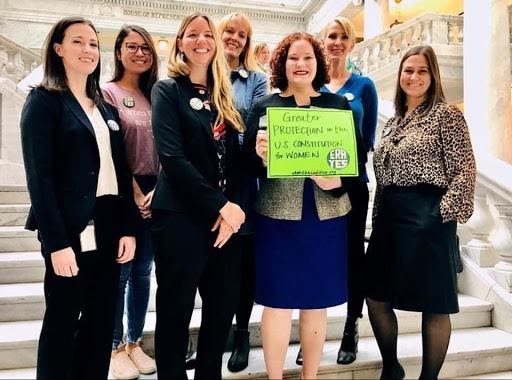
The Next Gen
Era
tion
The Next
Gen
Era
tion
“It's the right thing. It's the right time. This is the right place. And we are the right people,” 17-year-old Isabella Bartmess Park City High School said to cheers at the Utah State Capitol building, December 3, 2019.


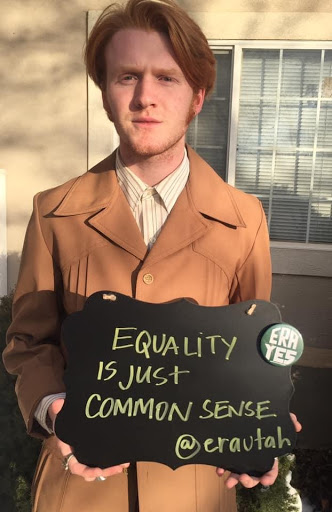
The youth-led movement to ratify the Equal Rights Amendment, was founded in July of 2019 by a few 15-year-old kids at a public library in Arlington, Virginia. Their mission is to correct the historical exclusion of women and people beyond the binary from our Constitution by mobilizing youth across the country to take action to ratify the Equal Rights Amendment and advance gender equality.
Our young people continue to define this important movement toward equality. The University of Utah ASUU student government, a student-led coalition member, signed the Resolution to Ratify and created and produced this informative video.
University of Utah's ASUU Supports Ratification of the ERA
View from the U presents their views on the Equal Rights Amendment in Utah.
FAQs
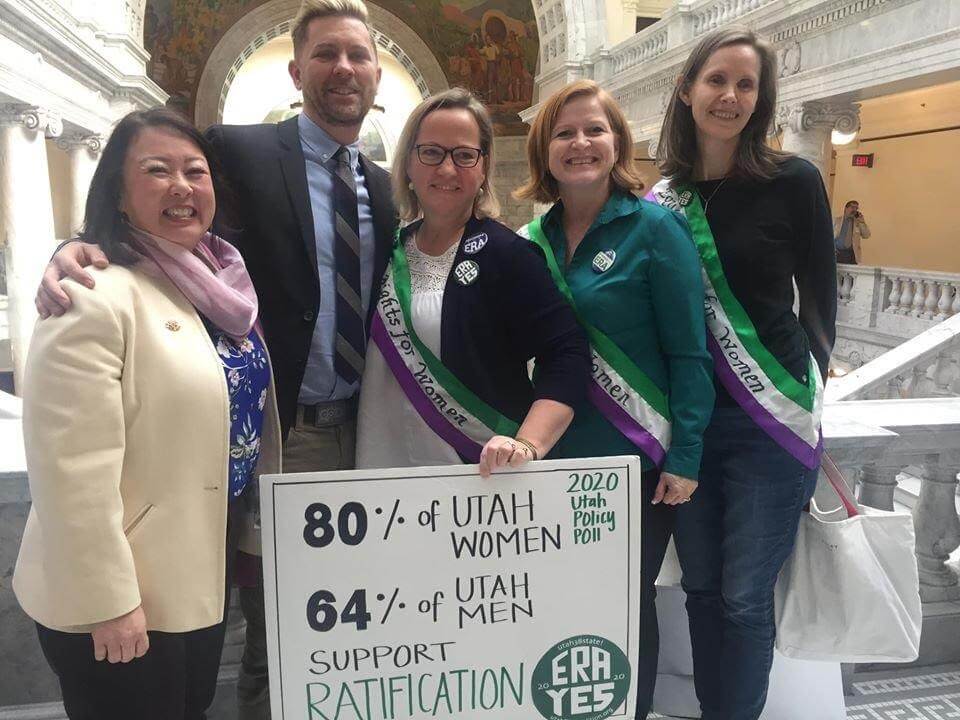
Yes. Fairness is a guiding principle for many Utahns. A 2020 Utah Policy Poll showed broad support across multiple demographics for ratification in Utah. This poll indicated that 67% of active and attending LDS Utahns support Utah’s ratification of the Equal Rights Amendment. And why shouldn’t they? Fairness for all is a guiding principle for our state. It is part of our heritage. Along gender lines, 64% of men support, while 80% of women support ratification. In a 2016 poll, 94% of Americans agreed that men and women should be in the U.S. Constitution. Eighty percent of respondents believed that it had been ratified.
Two independent polls show that Utahns broadly support ratification in 2020:
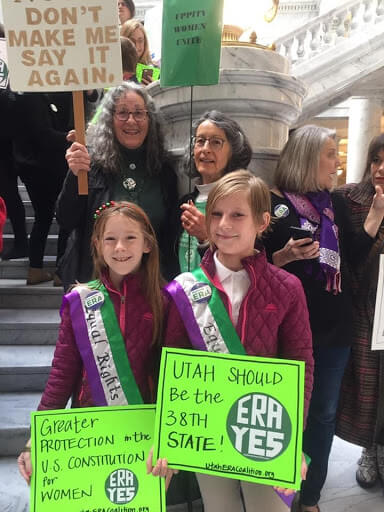
Despite progress toward greater equality under the law, these laws remain vulnerable to being changed and diluted to the point that they no longer serve the brave women who come forward. Companies can claim that things like no access to birth control, no lower lifting standards for pregnant women, and no breastfeeding breaks at work, apply to all of their employees, both male and female, and they can legally get away with it. Even though it only harms women and is a perfect example of sex discrimination. And they will win with that strategy. They have won in Walmart. v. Dukes, Ledbetter v. Goodyear, CastleRock v. Gonzales, Young v. UPS, U.S. v. Morrison, and Burwell v. Hobby Lobby.
Here are two examples of sex discrimination codified in law:
- Wal-Mart v. Dukes, 564 U.S. 338 (2011) Betty Dukes and 1.5 million employees of Wal-Mart sued the company for discrimination on the basis of gender, alleging managers routinely passed women over for promotions and pay increases. They lost, but not because there wasn’t a pattern of sex discrimination, but because the judge required each woman involved to sue each store individually, although there was a strong pattern of sex discrimination in over 250 stores. They lost because the judge required that they be able to prove a company-wide “intent to discriminate,” and intent is a high legal standard to prove. If there were an Equal Rights Amendment in the Constitution, women would be considered a “protected class.” In a case like this one, they would not have to prove “intent to discriminate,” but only prove that the sex discrimination occurred. This case limited the size of a class action suit, and forced women to go it alone in discrimination cases.
- Ledbetter v. Goodyear. Lilly Ledbetter sued Goodyear for wage discrimination. She worked for the company for 23 years. Due to discriminatory evaluation processes she received $15,000 less over several years than her male counterparts. The courts denied her past compensation and set a new precedent whereby employees are only entitled to be reimbursed for wage discrimination if they find the discrepency and report it within 180 days of the employer’s pay decision. Though there was a clear pattern of discrimination, the court found that she had to report every pay period that reflected discrimination as a separate EEOC violation. She lost this case in the Supreme Court with a 5-4 vote, though a jury had previously awarded her $360,000 in back pay. The Equal Rights Amendment would add teeth to equal pay laws and require courts to consider sex discrimination with more seriousness. Under the ERA, these cases would be held to a higher level of legal scrutiny, called strict scrutiny.
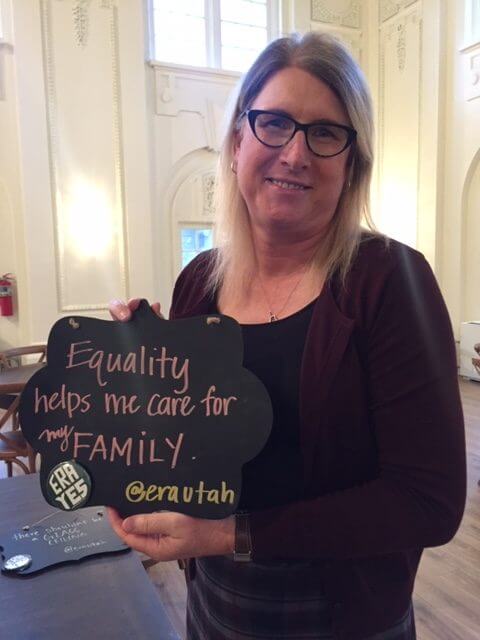
Yes. If we say we value women and we believe in fairness, then we must put all women in our most sacred document, the U.S. Constitution. The 28th Amendment will not make men and women the same as some argue. It respects that there will be times that we need to treat the sexes differently. It merely requires that when we do, we have a reasonable and consistent standard for doing so. Due to recent Supreme Court decisions, passage of the ERA will likely mean that judges would have to apply the highest level of scrutiny in challenges to the many state and federal laws that deny the LGBTQ community equal access to public accommodations, housing, employment, and education, among other things. The Equality Act proposed in Congress will attempt to address some of these issues, but just like The Violence Against Women Act, it will be a law and so it is subject to changes, unlike a Constitutional amendment. Instead of passing piecemeal laws this amendment will ensure that equality of rights under the law extends to all women. We must learn from our mistakes of the past, where women of color and others were left out of equality efforts, and truly commit to equality for all women. Of course, we know that the courts will look at when the amendment was written, when it was passed, and current law to understand its implementation. Once it is signed into law, the 28th Amendment will have two years to determine the particulars of existing law.

Utah and national suffrage leaders meet with Senator Reed Smoot on August 19, 1915. Photo courtesy of National Woman’s Party Collection, Belmont-Paul Women’s Equality National Monument, Washington, DC.
This amendment provides symbolic benefits for women. In a time when disrespect and discrimination against women has been exposed, Utah can set the standard in the nation for respect of women. Rep. Karen Kwan’s HJR 007 is a sister bill to last year’s HJR 021, reaffirming respect for women. During 2020, Utahans celebrate the efforts of pioneering women working for political equality with suffrage. Utah’s First Lady Jeanette Herbert described at a recent suffrage celebration in the Capitol the need ” to continue to be audacious in our pursuit of equal rights for all.” Having to win the right to vote not once, but twice due to the Edmunds-Tucker Act – means that Utahns have a long-standing tradition of equality to uphold. This article from Brigham Young University’s Daily Universe details that compelling history.

Christian Nunes
President of the National Organization for Women
Headline speaker at the Utah ERA Coalition’s Rally for Ratification at the Utah State Capitol Building, January 27, 2020
This amendment provides tangible benefits. The ERA would require a higher judicial standard of equal treatment for women and men. It will hold gender discrimination to a “strict scrutiny” standard when cases come before the courts, rather than the current “intermediate scrutiny” – a lower standard under the law. The 14th Amendment has been used inconsistently in some of these cases. But conservative Justice Antonin Scalia famously stated that the 14th does not cover sex discrimination. If the 14th was an equality amendment for women, the 19th Amendment would not have been necessary.
The American Bar Association with its 400,000 members supports ratification. Robert Carlson, ABA President, stated;
“The ABA has long advocated for gender equality and stands in full support of ratification of the ERA. Our policy-making body has adopted positions of support in 1972 and 1974, and most recently in 2016, when it reaffirmed the need for, and its support of, ratification of the ERA. The ERA is needed to assure that gender equality is recognized as a fundamental, irrevocable right protected by the highest law of the land.
“Ratification would have three immediate effects: First, it would establish that gender equality under the law is a fundamental and irrevocable tenet of our society. Second, it would require all judges to apply the highest standard of scrutiny when deciding cases involving sex discrimination. This means judges would use the same standard of review in sex discrimination cases that they now use in deciding cases involving discrimination based on race, religion, and national origin. Third, it would protect and reinvigorate enforcement of existing gender equity laws. We are encouraged that Nevada and Illinois [and Virginia] have recently ratified the ERA because it signals a renewed nationwide recognition of the need for the ERA and the public’s determination to transform legislators’ verbal support for equal rights into votes for ratification.” (ABA Journal)
For a local perspective, please read this opinion piece by Donna Kelly, prosecutor in the Utah Attorney General’s Office. Please also read this piece from Michelle Quist, a Republican attorney in Utah, and member of Women Lawyers of Utah, a Utah ERA Coalition partner

In the current economic climate, particularly in tech industries, qualified employees are more likely to accept employment if a company reflects their core values and principles. Recruitment and retention in our state require equality for all. Litigation is costly and impacts efficiency. Equality in professional life is good business practice.
See how Women in Big Law are stepping into the court fight over the ERA.

As more Utah families are dual-income, equity in pay allows women and men to better care for their families. Women make up 47% of people in the workplace, either by choice or by necessity. Single women make up 60% of the workforce. Yet, on average, women make salaries 80% that of their male counterparts, and 70% here in Utah. With wage equality, women would not need to spend additional time at work to earn the same amount as men. This would translate to more time elsewhere, such as at home with families — a great benefit for men, women and children.
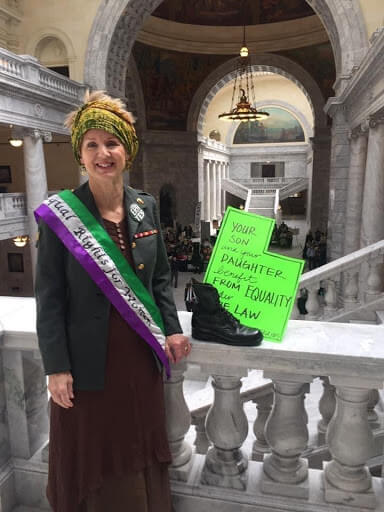
Women currently serve in every arm of military service. A key question from legislators is would their daughters be drafted into military service if the ERA is passed? Women can already be drafted without the ERA. Women have been draft able according to the Constitution since the Revolutionary War, and they have served in many capacities in every U.S. war. Mindsets are changing about military service, but women who serve still experience discrimination and a military glass ceiling when it comes to promotion. The Pentagon and Selective Service are reviewing their procedures to include women and men. It is unlikely that we will have another draft. We are currently an all-volunteer army, and we fight wars remotely with new technologies. But if there were another draft, and without any help from the ERA, women would continue to serve their country with honor and distinction. A Texas court found that the all-male military draft is unconsititutional in 2019. Men used their constitutional standing to win this case. Women would have constitutional standing to protect their interests under the ERA. Read more about the case here:
https://www.nytimes.com/2019/02/24/us/military-draft-men-unconstitutional.html
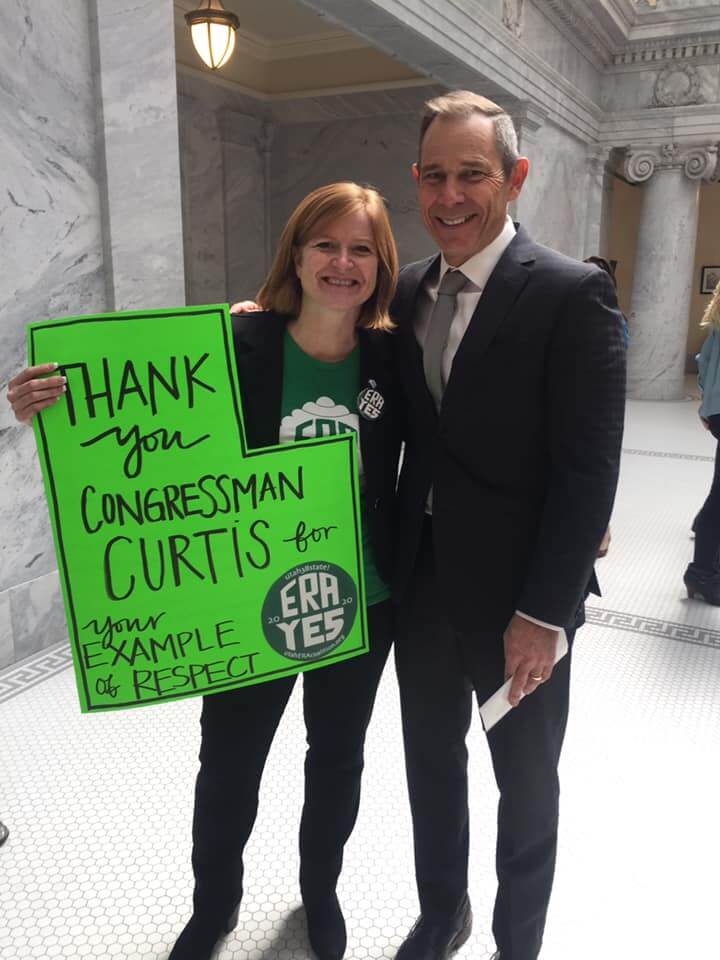
There is no time limit set for ratification of amendments in Article V of the U.S. Constitution. There should be no deadline on equality. We are living in this question right now, as the U.S. House voted in March 2020 to remove the arbitrary deadline given to the Amendment. There are sound legal arguments for why this timeline is not binding. It does not appear in the primary language, but as an addendum. Other amendments, such as the 27th Madison Amendment have had a similarly long road to ratification. Congress has the power to extend or remove the deadline and it has extended the deadline before. A bi-partisan companion bill, SJR6, proposed by Senator Murkowski and Senator Cardin is currently waiting to be heard in the U.S. Senate, and would remove the deadline from the ERA. A lawsuit to compel the archivist to sign the 28th Amendment into law is currently in Washington, D.C. This lawsuit was brought by the Attorneys General of Nevada, Illinois, and Virginia. Because amendments are so rare, and considered so necessary once passed, they are given special consideration when the 38-state threshold is reached, Closer to home, former Utah Supreme Court Justice Christine Durham said this, “The federal Constitution, which creates the process for amendment makes no mention of Congress having power to make deadlines and to cut off ratification efforts.” While some will take a wait and see approach to this issue, we submit that this is a moment to lead, like Congressman John Curtis and Congressman Ben McAdams did with their votes to remove the deadline. Utah should set the example.
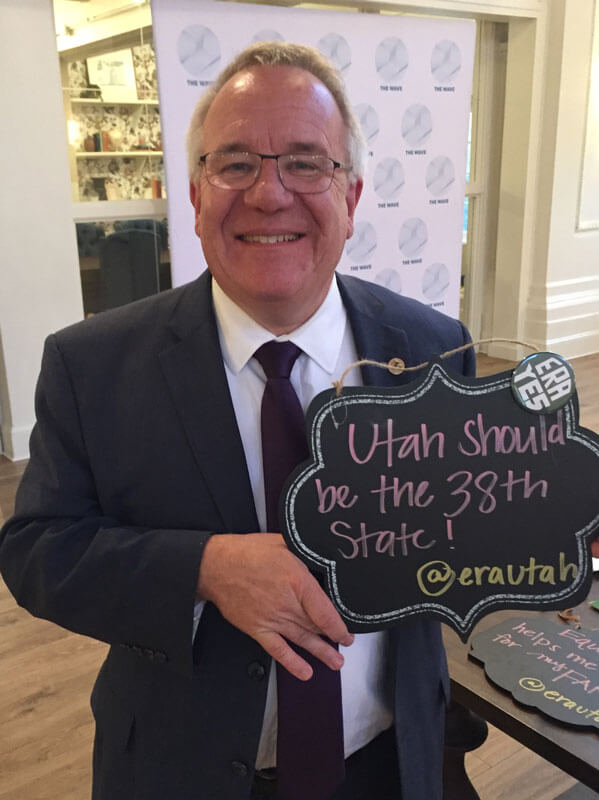
Representative Steve Andersson was given a pamphlet that made false claims. Curious and skeptical, he conducted an in-depth legal analysis and found there is no straight line from the ERA to abortion. Opponents often cite cases where a state has used their equality clause to fight anti-abortion lawsuits, to suggest a connection to the ERA. Several states have been successful in litigation, but only using medical privacy law and the definition of whether a procedure is considered “medically necessary.” Abortion became law under privacy law unrelated to equal rights law.
Proponents and opponents often suggest a link here, but there is no legal standing for this connection. See Andersson’s attached legal summary. Abortion and gay marriage are often brought up as reasons not to support the ERA, and yet they both became the law of the land through other means. Read his legal summary here.
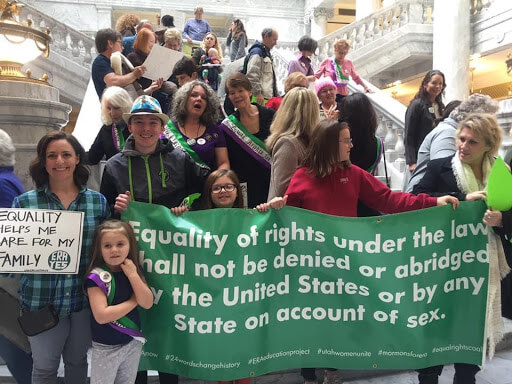
In a state, where 1 in 3 women experience domestic violence vs. 1 in 4 women in the nation, Utah has work to do to ensure women’s safety. The ERA will bolster respect for women and provide better legal protection against harassment in professional life, and in the home. This amendment ensures that equal treatment laws cannot be walked back, watered down, and reversed by the whims of one court, one administration, or one Executive Order. The Violence Against Women Act, a bi-partisan bill since 1994 was defunded by Congress this year. It has enjoyed bi-partisan support for a decade. Our state uses those funds for Domestic Violence Resources and must now scramble to find alternative funding to cover these vital programs. The ERA would offer support for necessary federal acts like this one.
Title IX protections meant to protect against sexual assault on college campuses are being diluted. When an estimated 85% of campus sexual assaults go unreported, changes to settled federal law by Secretary of Education DeVos will increase barriers for assault victims to report violence and receive justice. Assault victims were excluded from this process of drafting new campus policies. The concerning impacts of these changes include;
- The conduct for sexual harassment must be “so severe, pervasive and objectively offensive” as to deny a person equal access to a school program or activity; (think about that level of proof).
- Requires victims to endure repeated and escalating levels of abuse before meeting the threshold for filing a complaint. (again, some may think this is a good change, but escalating levels–not just repeated).
- A victim is only entitled to protections against harassment if they were participating or attempting to participate in a school-controlled education program or activity in the United States. (Think how limiting this is)
- Tilts the scale in favor of respondents by offering schools the option of using a “clear and convincing evidence” standard in their Title IX cases. This is a higher burden and a dramatic deviation from the “preponderance of the evidence” standard that has previously been deemed appropriate and used by courts in all civil rights cases. This puts a heavy burden of proof on victims to prove their case and denies equality in the process.” (Why the higher burden than courts use?)
- Allows perpetrators to make public an incident that most survivors would prefer be kept private and within the confines of a confidential investigation and hearing. (Folks have wanted the defendant to be able to investigate, but this goes too far.)
- Gives more rights to the accused, “alleged student perpetrators will have added protections, including the presumption that they are innocent throughout the disciplinary process and the right to be provided all evidence collected against them.” (Where else do you get a presumption of innocence in a civil case? You don’t. If somebody sues you for sexual harassment in civil court, you don’t get a presumption of innocence).
- Allows schools that are governed by a religious organization to completely opt out of the Title IX rules, protections and process by asserting that the law is inconsistent with the religious tenets of the organization.
- Allows students to cross-examine their accusers and vice versa during live hearings, although it must be done through a lawyer or representative.
- Every state has adopted protections in the criminal justice process, known as rape shield laws, which recognize that a victim’s sexual history is irrelevant to determining consent in an incident of alleged rape. The new rules get rid of that shield. (Unacceptable).
The Equal Rights Amendment may potentially bolster and cement protections for assault survivors so they cannot be changed and diluted at the whim of one administration. See more about these changes that went into effect August 2020 here.

The ERA would not transfer jurisdiction of any laws from the states to the federal government. It would simply be one more legal principle among many others in the U.S. Constitution by which the courts evaluate the constitutionality of governmental actions. This amendment would impact federal statutes and guide legal decisions going forward. It does ensure that Equality should not depend on where you live. Like Utah, twenty-five states have equal rights language in their state constitutions, but Utah women travel and should be protected state-to-state. The ERA would provide a consistent standard.
(Please refer to our State Constitution language.)

Utah cares about families and ensuring that men and women are able to support their families whether they work outside or inside the home. Recent measures show us that we have room to improve when it comes to fair wage and 13 other equality measures. Read the latest about Utah’s wage gap here:
Utah ranks last in the nation for gender pay equity. In 2014, Utah’s Department of Workforce Services listed institutional gender discrimination as being 5.4% of the 30 cent gender wage gap, when all other employment factors are the same. The Salt Lake Chamber of Commerce offers additional information.
Read more about the Elevate Her Challenge and the Parity Promise; two programs Utah Businesses are adopting to elevate the status of Utah women.
Pivotal research being done by Susan Madsen and the Women’s Leadership Project at Utah State University is exploring how we can work together to make the workplace more equitable. Particularly, they are focused on how men in the workforce can be allies and mentors in this process. Read more about wage parity efforts here.
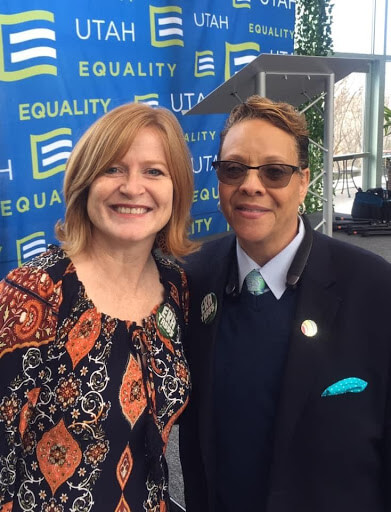
This amendment provides fundamental protection and will raise the standard of respect for women across the nation. If we say we value women, then we must put women in our most sacred document, the U.S. Constitution. Rep. Karen Kwan’s Bill HJR 021, unanimously passed the Utah Legislature in 2019, reaffirming the value of women. This bill had bi-partisan support. Equality is not a partisan issue. Both major political parties listed the ERA on their platforms until the 1980s.
Kwan also ran HB 007 in 2020, a bill to ratify the Equal Rights Amendment in Utah, but the bill was not allowed out of Rules Committee for the second year. Utah women remain undaunted, and they have terrific allies in this effort. Senator Pat Spearman (pictured at the Equality Utah’s PAC Brunch 2020) ran and ratified the Equal Rights Amendment in Nevada in 2017, reviving a century-long push for women’s equality. Illinois and Virginia followed in 2018 and 2020. A veteran, a woman of color, and a gay woman, Senator Spearman jokes that “equality might as well be my middle name.” She describes that “there’s not any part of me that I can bring to the conversation that has not experienced discrimination…discrimination in life, discrimination in the military, discrimination, even in church.” Her life’s work is to ensure that all women have access to fundamental rights and equality under the law. Senator Spearman believes we are all called to this work, saying “we are made for this time.” Read more about her extraordinary journey for equality here.
Under the Convention on the Elimination of All Forms of Discrimination Against Women (CEDAW), The United States requires new democratic nations to write equality of men and women into their constitutions, but not our own. https://www.un.org/womenwatch/daw/cedaw/
More
Legal Efforts
What's next for the ERA?
- Legal Efforts: Litigation over timeline on ERA
- Utah ERA Coalition Joins Amicus Brief: In May of 2020, the Utah ERA Coalition is proud to have signed onto the Amicus Brief in Washington, D.C. to compel the Archivist to sign the 28th Amendment into law. This litigation was brought about by the Attorneys General of Virginia, Illinois, and Nevada.
- Once the 38-state threshold has been met, this process should be automatic under Article V. of the U.S. Constitution. Click here to read more about these efforts.
Helpful Printables
- Common Myths
- Utah Historical One Sheet
- Utah Policy Poll. 71% of Utahns Support Ratification of the ERA in Utah this year. 2020 Poll breaks down the numbers by political party, religious affiliation, and gender.
- Salt Lake Tribune/Suffolk University Poll Nearly 70% of Utahns Support Ratification
- Resolution to Ratify for Organizations/Corporations

